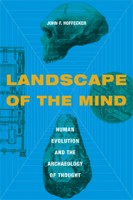 Author: John F. Hoffecker
Author: John F. Hoffecker
Publisher: Columbia University Press – 259 pages
Book Review by: Deekay Daulat
Chances are, you have not come across the phrase ‘the archaeology of thought’ because when you think of archaeology, you think of something physical, like bones, tracks of leaves etched on stone, and the like.
Well, as they say, you learn something new everyday. Thought is produced by the human mind, and the seat of the human mind is the human brain. This book, as the writing on the inside jacket flap states, “explores the origin and growth of the human mind, drawing on archaeology, history, and the fossil record.”
The author John F. Hoffecker – who is associated with the Institute of Arctic and Alpine Research at the University of Colorado at Boulder – suggests that “as an indirect result of bipedal locomotion, early humans developed a feedback relationship among their hands, brains and tools that evolved into the capacity to externalize thoughts in the form of shaped stone objects.”
Those shaped stone objects of our earliest ancestors somehow evolved into symbols of language. But that is not quite clear, since we all have known or been taught that those oval pieces of stone with sharp edges were used to kill or disable animals that were then used for food by the earliest humans on earth. So to jump to the idea that those sharp, shaped stones were language symbols and not hunting tools takes a big leap in thinking.
The writing on the inside flap continues to state that “when anatomically modern humans evolved a parallel capacity to externalize their thoughts as symbolic language, individual brains within social groups became integrated into a “neocortical Internet,” or super-brain, giving birth to the mind.” So I suppose those stone tools developed a secondary purpose: objects for communication with other humans, in prehistoric times.
That the capacity of the human mind grew as more and more symbols were drawn to represent actual objects, which then developed into language, is one of the central theses of this book. For example, the earliest drawings from prehistory were depictions of different animals on land and in the sky such birds. Those drawing also showed the sun, the stars, the moon, clouds, etc. The use of symbols gave way to the development of written language which later developed into a spoken or oral form.
Hoffecker links the growth of the mind with human history, which, he states, began in Africa more than 50,000 years go. He points out as humans spread to other places of the earth, they adapted themselves physically to different climates and habitats, and in the process “redesigned themselves technologically and created alternative realities through tools, language and art.”
The author writes that there is close linkage of the rise of human civilization to the “hierarchical reorganization of the super-brain, triggered by explosive population growth” It is easy to understand that more people meant more thinking and more ideas for improving human life. When ideas were shared as the tools of communication increased in quantity and quality, living standards grew.
But he asserts that the progress of civilization was slowed when the creativity of humans was stifled by their fellowmen. “Subsequent human history reflects to varying degrees the suppression of the mind’s creative powers by the rigid hierarchies of nation-states and empires, constraining the further accumulation of knowledge.”
The modern world as we know began after the year 1200, the author points out. It “emerged from the fragments of the Roman Empire, whose collapse had eliminated a central authority that could thwart innovation.
A long period of growth ensued, and the quality of life has been raised for most people since that period in history. So what lies ahead for humans? Hoffecker concludes the book by speculating that artificial intelligence could develop and advance. Already we have seen computers make decisions for humans and communicate with other computers.
But a lot of us worry when non-human machines make decisions for us and in effect dis-empower us, taking away control of many aspects of our lives. The author ruminates about “the consequences of a mind liberated from its organic antecedents to exist in an independent, non-biological form.”
This is a fascinating book on a subject that most of us do not even think about – the human mind: its history and evolution, its present state, and its future dimensions and exciting capabilities. John Hoffecker takes you on an illuminating journey and is truly an intellectual pioneer.
He also presents to you ample opportunities to find out more about this subject in the form of about 80 pages of notes and bibliography, more than 30 percent of the length of this book.
John F. Hoffecker is a fellow of the Institute of Arctic and Alpine Research at the University of Colorado, Boulder. He is the author of A Prehistory of the North: Human Settlement of the Higher Latitudes and coauthor of Human Ecology of Beringia, which was named a Choice outstanding academic title.






